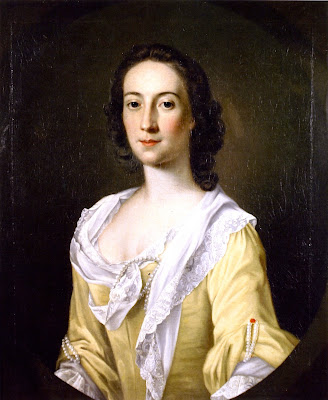Susannah Smith Preston c. 1760 (via The Athenaeum) A subtle suggestion of a front-closer, but it's there.
These paintings, all of which are attributed to British native John Wollaston, intrigue me. As a general rule, it seems to be accepted that front-closing gowns were not a fashionable option in America until the 1770s. Certainly, most of the front-closing gowns in museum collections today seem to bear that theory out. But John Wollaston disagrees. It is always a tricky thing to consult a painting, particularly an 18th century painting for "correct" historical fashion. The temptation to use allegory was just too damned strong, I suppose. But paintings can't be entirely discounted either.
Lucy Parry, dated 1745-49 by the Smithsonian Museum of Art. (via It's About Time)
On a recent trip to Washington DC, I stumbled accross the divine Ms. Lucy up there and stood agog for several minutes admiring the magnitude of her awesome retina-burning whiteness. Then I started noticing the front closure of her gown. Then, the sleeves... definitely *not* 1770s. But that front closure! It may be difficult to see in the small image that I was grateful to find at It's About Time, but the front closure of this gown is anything but allegorical. In the original painting, which is nearly 4 feet by 5 feet, you can clearly see the puckers caused by the pins that are used to secure the two sides of the bodice. (You can actually see the heads of a few of the pins as well.) The pattern of strained fabric around the pins is distinctive and inimitable.
And it's not just Lucy, as it turns out:
And it's not just Lucy, as it turns out:
Elizabeth Tasker Lowndes c. 1754 (via this wacky genealogy site) Lizzie is entirely too pleased with herself for remembering to wear the bosom ribbon that matches her favorite teal deflated inner-tube.
So naturally, I came home and immediately started googling the painting and the artist, John Wollaston. According to Wikipedia (always an entirely reputable source...) he was very keen to accurately represent the fashions of his female subjects. I don't know how true that is*, but it must be said that he was at least willing to paint a puckered seam now and again.
* Take, for instance, the fact that nearly every man, woman and child he painted all have the same apparently oriental ancestry. It's the eyes. What's with that??
Moral of the story? This is me, so no morals. But seriously! Lookie at them thar front-closin' gowns!



Oh boy. I know this is very un-PC of me, but the eyes on the last two look positively Down Syndrome. And WHAT is going ON with Susannah's pearl scarf-catcher in front? It's like the necklace fell off her and Wollaston just decided "oh I won't tell her, I'll just keep painting."
ReplyDeleteThe front-closing is interesting, as is the fact that neither of the two full-length gown paintings are open-front but full round-gowns. It kind of makes me feel like he may have thought to himself "oh f--- it, I am NOT painting all those frills and fripperies in different colors. Round gown it is!"
I'm so happy to have found this post! This mystery has plagued me for quite a long time. I work in a museum that displays eight Wollaston portraits from 1760 to about 1772, and five of those are women with front-closures on their dresses. Visitors on my tours ask constantly if it was typical for the ladies of the time period to bare so much skin and wear these low-cut styles. What they seem to overlook, however, is that every single one of those five women is wearing THE EXACT SAME DRESS in different colors!
ReplyDeleteThe historians for the site found an interesting tidbit about Wollaston and his business habits. Apparently he was fond of painting the bodies in the portraits ahead of time (sometimes more than a hundred of them) using whatever clothing was fashionable. When you commissioned him, he would roll up a dozen or so of these pre-painted canvasses, bring them to your estate, and then let you select the body you liked best. He was quite popular with the Virginia gentry because he was able to reduce the time spent sitting for portraits to only a day or two using this technique.
I have to wonder if some of these "out of era" fashions were canvasses that had been in his trunks since his time in England...
Sorry I've taken so long to reply to your post. It came during exams this past semester. You've shed new light on these paintings for me! Thank you. I've heard of the "itinerant painter with a box full o'bodies" trick while on historic home tours in the past. I had no idea Wollaston was one of them. It certainly does bear out that he artificially introduced this bodice-style in a geographic region where it was otherwise little-known.
DeleteI can't imagine it would have been hard to convince his sitters that they were going to be portrayed at the very height of fashion. He didn't really work in the "backwoods," but the colonies were definitely a far cry from London.
Thank you so much for your comment!